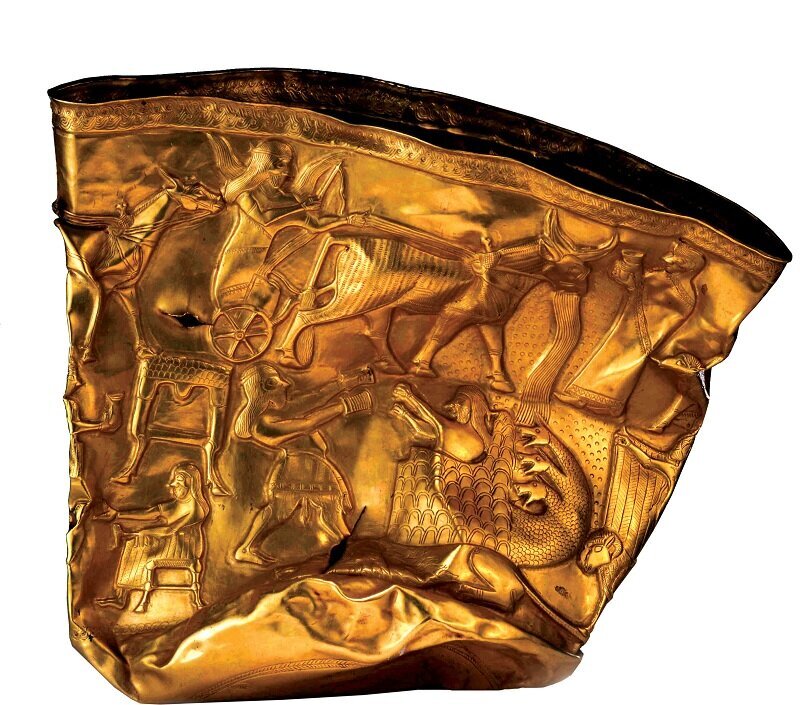The absolutely magnificent ‘Gold Bowl of Hasanlu’: Sixty-three years later

TEHRAN – Sixty-three years ago, an Iranian man, named Emamqoli Mohammadi Hasanluei, unearthed a millennia-old gold bowl in the debris of a burned building, part of the major architectural complex at Teppe Hasanlu near the city of Naghadeh in the northwestern province of West Azarbaijan, a short distance south of Lake Urmia.
It is here, when in 1958 archaeologists came across a layer of an Iron Age city that had been frozen in time - a ‘burn layer’ containing tens of bodies preserved in ash and rubble. Teppe Hasanlu consists of a 25m high central mound with massive fortifications which is thought to be once a citadel surrounded by paved streets and an outer town with houses, stables, and temples.
Engraved with images of gods and rituals, a stone cylinder with gold caps, a figurine of laminated ivory, and a sword-hilt with a bronze guard, the Gold Bowl of Hasanlu is named after the man who discovered it almost 3000 years later not far from a skeletal hand of an individual who had been fleeing with the piece at the end of the 9th century BC. The excavation was led by the celebrated anthropologist and archaeologist Robert H. Dyson, Jr., who shined at Iran’s archaeology scene in the mid-20th century.
In no time it became evident that the bowl epitomized a unique and significant example of the ancient goldsmith’s expertise, demonstrating a high degree of technical mastery and a wide range of ornamental motifs that were deemed to provide a key to the religious and mythological traditions of its time.
Over the years, the bowl has been discussed in countless scholarly books and articles including an analysis by Marie-Therese Barrelet (1911-1996) as one of the greatest finds of the decade. Images of the crumpled yet still dazzling bowl appeared on newspapers around the world, and scholars began publishing their interpretations of the images etched onto this magnificent artifact.
Some evidence suggests when the citadel of Hasanlu was under violent siege some soldiers could penetrate into the citadel grabbing a handful of valuable treasures, including the treasured gold bowl. The hypothesis suggests that the whole building was collapsed due to fire, crushing the warriors and their prized possessions under layers of debris. And here they remained for around 3,000 years until the ground-breaking discovery in 1958.
Due to the lack of written records, very little is known about the inhabitants of Hasanlu, and their invaders. “There is no written evidence from Hasanlu that would attest to the identity of the inhabitants. We know neither the ancient name of the site nor the state to which it may have belonged, much less the linguistic and/or ethnic affiliations of its population – neither preceding nor during the period with which we are concerned,” writes Irene J. Winter in an article titled “The Hasanlu Gold Bowl: Thirty Years Later”.
Among the most important objects uncovered at Hasanlu were an unusually decorated silver bowl, several iron garment pins headed by bronze lions, a solid gold bowl, a knife handle with gold cloisonné, and two hollow bronze horse heads that served to hold liquids.
According to the Britannica Encyclopedia, Hasanlu was inhabited from about 2100 to about 825 BC, but the richest period yet excavated dates to the 10th and 9th centuries BC. The period, often called “Mannaean” after the name of the people who lived in the area, is characterized by gray pottery accompanied by black and red varieties, the black ware being of a much finer quality and probably made in imitation of metal vessels.
Experts say parallels to the motifs on the Hasanlu objects have been found in Elam, Assyria, north Syria, and Urartu, indicating that Iran not only received considerable cultural and artistic stimuli from other areas but also, in turn, exerted influence on the Middle East.
The Gold Bowl of Hasanlu is being kept at the National Museum of Iran in downtown Tehran.
AFM/MG
